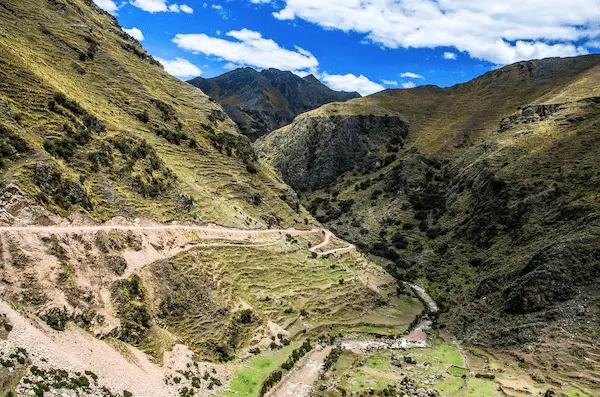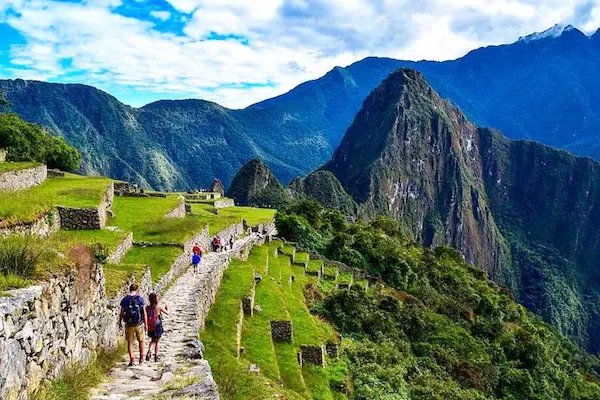Av Retamayoc L-10, San Sebastián 08002
- +51 940 809 144
- Travel Blog
- About Us
- Contact Us
Secure your spot on the Inca Trail 2026. Journey beyond the ordinary Secure your spot today
Av Retamayoc L-10, San Sebastián 08002
Chat to a Andean Road Peru
Have you ever wondered how the Incas managed to keep an entire empire united through mountains, deserts, and jungles? Well, the key was primarily their incredible inca road system, or as they called it, the Qhapaq Ñan. This system didn’t just connect the entire empire; it was a masterpiece designed to organize the whole Inca civilization. In this blog, I’ll tell you how the Incas left us a legacy of routes so well-built that, even after centuries, we still walk them today, amazed by their design and how well they’ve been preserved.
The Inca Road System began to develop around the 15th century during the reign of Pachacuti, the ninth Inca emperor. Pachacuti is recognized for transforming the Tahuantinsuyu, the vast Inca Empire, into a cohesive entity thanks to the reforms he implemented, and one of the most notable was the construction of a network of roads that united all the regions of the empire.
The most important road of this network was the Royal Road or Qhapaq Ñan, which extended from the north, in present-day Ecuador, to the south, in northern Chile and Argentina. The road system also connected all the major cities and administrative centers of the empire, including Cusco (the capital), Arequipa, Quito, and La Paz, among others.
Maybe you’d like to read: Family trip to Peru with activities for all ages

The Inca road system wasn’t just a network of paths; it served as a highly organized and sophisticated structure, built with key features that enhanced mobility, trade, and administration.
The Qhapaq Ñan covered about 40,000 kilometers of interconnected roads through the Andes. This made it possible for the empire to communicate and maintain efficient control over its territories. In addition to the main routes, there were secondary roads that connected various communities, allowing the dispersion and growth of Inca trade and culture.
This road network stretched so vast and complex that it compares to the large transport infrastructure networks of other ancient civilizations, like the Roman road system. However, the uniqueness of the Qhapaq Ñan lies in how it adapted to the extreme geographies of the Andes.

Inca engineers faced numerous geographic challenges while building these roads. They successfully adapted the system to diverse terrains, from the high Andean mountains and arid deserts to dense tropical jungles. The Incas used various engineering techniques to overcome natural barriers, such as suspension bridges, tunnels dug into rock, and steps carved into rocks to ascend the steepest slopes.
One of the most remarkable examples of this engineering was the construction of suspension bridges over the deepest canyons and fast-flowing rivers. Using natural fibers such as k'epi (a type of grass rope), the Inca engineers built extremely strong and functional bridges, which were not only practical but also demonstrated their mastery of local materials.
The roads were built with a robust and high-quality structure. The primary material used in their construction was stone, which ensured durability even under the harshest conditions. They employed mortarless masonry techniques, which allowed the stones to fit perfectly together, creating a solid base that withstood the test of time. In addition to the stones, the roads covered with compacted earth or gravel provided a firm surface for the passage of people, animals, and vehicles like llamas. In some regions, workers paved the roads with a layer of carefully placed stones, while in others, compacted earth sufficed to allow the smooth passage of travelers.
Today, travelers can still explore these ancient paths, with one of the most popular ways being a Machu Picchu 4 days, where they can walk along the famous Inca Trail and marvel at the same roads that once connected the vast Inca Empire.
Along the roads, rest stops or "restingas" were established. These were areas where travelers could rest, resupply, and change their llamas or messengers. The importance of these restingas was crucial for the rapid transport of messages and goods throughout the empire.
One fascinating feature of these restingas was their organization. Travelers and messengers using the quipu system (a knot-based code) could continue their journey with little disruption. These restingas also played a crucial role in Inca state control, as officials oversaw resource management, tax collection, and local activities.
Maybe you’d like to read: Guide to knowing what to do in Peru?

The Qhapaq Ñan was essential for the functioning of the Inca Empire in various areas:
The road system facilitated the transportation of goods between different regions of the empire, enabling the exchange of products such as maize, quinoa, cacao, gold, and textiles. Llama caravans, which could carry up to 40 kg of cargo, were essential for trade and the distribution of food and resources. Thanks to the road network, trade between coastal regions, mountains, and tropical jungles was more efficient and effective.
The Qhapaq Ñan also served to transport sacred products and offerings to ceremonial and religious centers. This showed how the infrastructure not only supported economic activities but also helped maintain the empire's spiritual and cultural unity.
One of the reasons the road system was so important to the Incas was its ability to quickly mobilize troops and resources. The empire was divided into territorial sections known as "Tupac." Each Tupac had a main road connecting it to other Tupacs. This system facilitated administrative control and the rapid movement of troops in the event of conflict or emergencies.
Furthermore, the road system allowed Inca rulers to communicate effectively with the most distant regions of the empire, enabling them to make swift decisions and maintain centralized governance.
The roads also played a key role in spreading Inca culture and religion. Temples and sacred sites were connected by the road network, making pilgrimages and the dissemination of religious practices easier. The most important religious centers, such as Sacsayhuamán and Qorikancha in Cusco, were accessible from various regions, allowing communities to gather for religious ceremonies and festivals.
The connection of sacred sites via the Qhapaq Ñan also allowed the Incas to reinforce their political and spiritual influence. Movement between these centers helped consolidate the idea of the panacas (the royal house) and the vision of an empire under the divine mandate of Inti, the sun god.
The road system began to deteriorate after the fall of the Inca Empire at the hands of the Spanish conquerors in the 16th century. Despite the partial destruction of the infrastructure, many sections of the Qhapaq Ñan have survived to this day, demonstrating the quality and durability of Inca engineering.
Although the conquistadors destroyed much of the infrastructure, local indigenous communities continued to use the road system, maintaining the routes as they knew them. However, the arrival of colonization and the subsequent repopulation of the land affected the extent and state of conservation of the ancient Inca roads.
Maybe you’d like to read: 20 Interesting facts about the Incas

Today, the Inca Trail is one of the most popular trekking routes in the world. Every year, thousands of tourists from around the globe travel this trail to reach Machu Picchu and experience the natural beauty and history of the Inca civilization up close. The journey not only allows visitors to immerse themselves in a spectacular landscape but also provides a unique opportunity to connect with the culture and legacy of the Inca Empire.
However, to protect the site and preserve its integrity, the Peruvian government regulates access to the Inca Trail, limiting the number of visitors to guarantee the conservation of the trails and archaeological remains. The government allows only a specific number of tourists per day, requiring them to obtain special permits to do the trek. The Classic Inca Trail is part of this protected network, and it remains one of the most sought-after hiking routes in the world.
The Inca Road System continues to be one of the major tourist attractions in South America. Millions of tourists travel each year to explore some of the most famous sections of the Qhapaq Ñan, such as the Inca Trail to Machu Picchu, one of the Seven Wonders of the Modern World. This tourism not only supports the economy of the countries involved but also helps preserve the roads by raising awareness about the importance of conserving these historical treasures.
In academia, the study of the Qhapaq Ñan remains a source of fascination. Archaeologists and historians continue to investigate the construction techniques used by the Incas and how this system contributed to the administration, social control, and cultural dissemination of the empire.
Walking the Inca Trail is also a physical challenge. Hikers must traverse steep terrain, climb considerable altitudes, and walk for several hours each day. The reward is undoubtedly the majestic Machu Picchu, but the journey itself is a unique experience where one can feel a deep connection to the nature and history that once existed in this very place.
So, as you can see, the inca road system wasn’t just a bunch of stones and cobblestone paths. Rather, it was one of the foundations that helped build and keep the entire Inca Empire connected. And even though the Spanish conquistadors dealt a heavy blow to the system, the truth is that, in some way, the Inca roads are still alive! Not only because we still use them for Machu Picchu tours, but because they stand as a testament to how advanced our ancestors were in terms of engineering and organization. So, if you ever dare to walk these paths with a tour operator, remember this: you won’t just be walking through history, but also through a still-beating Inca wonder.
Leave a comment